The Ocean-Room and the Speculative Architecture of Empire
In the many-chambered heart of American empire was once a room, and in that room, an ocean. The room was Pringle Hall, the onetime centerpiece of the Naval War College (NWC) in Newport, Rhode Island. It is, at first glance, unremarkable. A 1934 photograph shows a skylit, double-height space ringed by a split-level mezzanine, a floor tiled in black-and-white linoleum. A few curtains, a chalkboard, some assorted desks, tables, and stools encircle an irregular cordon. Therein lies the ocean.
The ocean, however, appears only in an encrypted spatial form. Colored chalk diagrams trace out the movements of ships navigating unseen currents, waves, and weather. These are the spoor of sweeping, speculative sea narratives played out with scale models and chalk, of “strategic naval war games” through which American empire dreamed itself—and its limits—oceanographically. The games were “exercises in the art of war... worked out upon maps or tables with apparatus designed and constructed to simulate, as nearly as possible, real conditions,” where plans and wills alike could be designed and put to the test.1
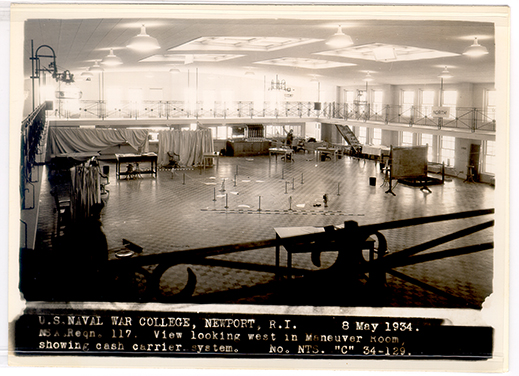
The resulting gyre of linework masks what their inventor William McCarty Little described as their “cinematographic” construction: a serial narrative composed through stepwise “chart maneuvers.”2 Following the knotted figures plays back the contrapuntal maneuvers of opposing fleets. Scattered measuring wands for evaluating distance, manuals listing ship and armament properties, and turning cards for computing maneuvers hint at the complex algorithmic operations subtending each point, line, and annotation. Marks on the scaled tile grid show each shot fired and each vessel sunk.
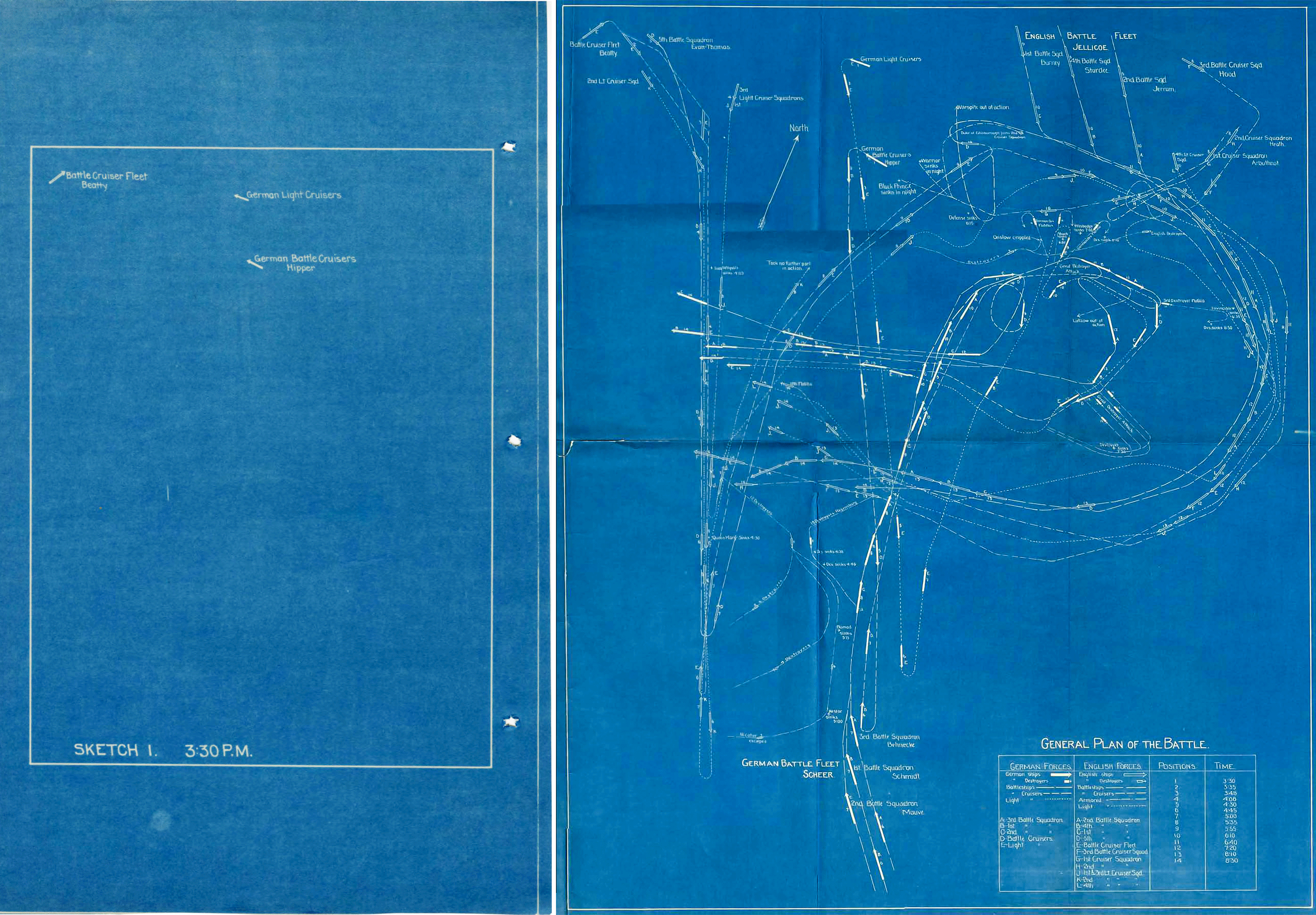
The professionally drafted records of these imagined wars were, according to one alum of NWC, akin to “the drawings that an architect makes of a house… altered and related until the best result seems to have been attained.”3 They were more, however, than blueprints for novel naval strategy. The ocean-room became a “drafting-room” for designing something more elemental and expansive: an empire built in the form of a “vast and new machine”4 running on “sea power,” following two-time NWC president Alfred Thayer Mahan’s coinage. The final, compound sigil of maneuvers is, in this sense, a cipher for the oceanic designs of US imperialism.
But it is only one of many such plottings. The game ended and ritual drawing complete, a janitor arrives to wipe the tiles clean, preparing the ocean-room for another day. The fresh floor plane flattens the hidden sheaf of games past, rounds and hands lost, invented campaigns failed. It is an archive of error and miscalculation as much as a proving ground for experimental plans adopted—dreams of empire designed, some deferred, mostly destroyed. A dustbin not of histories but of futures.
Gaming Global Race War: White World-Supremacy vs. the Rising Tide of Color
Between 1887 and 1941, NWC staff like Mahan, student-officers like WWII Pacific fleet commander Chester Nimitz, and government officials like then–assistant secretary of the Navy Theodore Roosevelt used “the Game”—i.e., both model of war and discrete simulations—to play out hundreds of scenarios in Pringle Hall and its forebear, Luce Hall. Over that half-century, the “sea” in question shifted with the gaze of imperial power. Early academic games distilled transhistorical principles of naval warfare by reenacting canonical battles from which Mahan drew his celebrated theory of sea power. Later games migrated first to possible campaigns against European adversaries in the North Atlantic and Caribbean, then, overwhelmingly, to the Pacific and its constitutive “problem of Asia” where Mahan, Roosevelt, and their ilk saw the “horizon of the future.”5 Roosevelt, who used the Game for his own imperial designs, proclaimed in 1904 that “the commerce and command of the Pacific will be factors of incalculable moment in the world’s history.”6 Whoever controls the Pacific, it went, would control the world.
But as the Game moved from historical scenarios centered on the Atlantic world to imagined Pacific futures, the kind of war it modeled transformed with the colonial geographies it transited: from war between white imperial powers over world-historical spaces to war between white and “dark races”7 for control of an inchoate globality at once produced and partitioned by racial difference.8 Anticipating neo-Malthusian and mutually assured destruction Cold War games by more than half a century, the Game played out an increasingly paranoid logic of racial difference expressed as a geopolitical contest for resources, labor, and markets. The lines on the ocean-room floor were not merely the record of maneuvers for a series of naval war games: they were tactical tangents to W. E. B. Du Bois’ “global color line” that, when braided back together, trace the emerging strategic geometries of a global race war game.
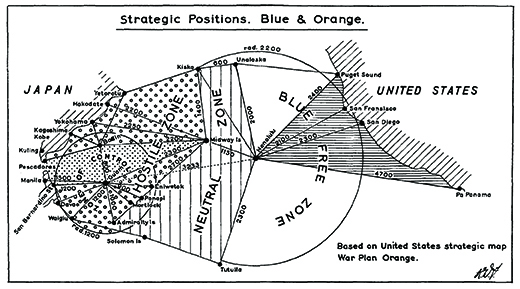
The Game took three primary forms: strategic (“Strat”) problems played out on charts, tactical (“Tac”) problems played out on the game floor, and, later, operational (“Op”) problems that integrated both. While the geographic and contextual details of each “problem” changed from year to year to reflect contemporary intelligence and political priorities, the metageographic “problem of Asia” loomed over the Game from the late nineteenth century through the onset of World War II. For Mahan and his peers, that problem was twofold: first, the problem of which western imperial power would exploit and control the outflow of East Asian resources, labor, and capital; and second, the ascendancy of Japan as regional and potentially hemispheric hegemon to the exclusion of western powers altogether.
At the NWC, gaming out the “problem of Asia” would therefore always orbit around conflict with the Japanese Imperial Navy. Of the records that remain for the 318 individual games simulating 137 separate scenarios from the core interwar period (1919–1941), all but nine modeled campaigns against Japan.9 While NWC staff developed Japan-centric scenarios since around 1897—some of which even involved alliance with Japan against Russian, German, and French imperial rivals—it was not until a decade later that then-president Roosevelt would request formal plans against Japan as a definitive geopolitical adversary. This shift came after waves of so-called yellow peril—racist mob violence, legalized segregation, and land expropriations targeting Japanese and Chinese immigrants—rippled through the Pacific coast states. Infused with Mahan’s ideas, the Game rapidly absorbed this more existential sense of the problem. If the first part of the problem—rivalry between white powers—presumed the unchecked “westward course” of the imperial mode of white supremacy, the second introduced an unthought and unthinkable deviation of the world-historical future hinged on domination of the Pacific: What if that future belonged to a non-white nation? What if the global “transit of empire” did not complete the circuit of white supremacy, enclosing world history, but fatally disproved its premise, breaking open radically new future configurations of global space?10 What if that globality bent toward the subalternity of whiteness rather than its superiority?
This emergent globality of potential race war was subtended by a “global idea of race” even longer in the making.11 The comprehensive—and humiliating—victory of the “colored” Japanese Imperial Navy over the “white” Russian fleet at Tsushima in 1905 tightened the articulation between the global imaginary of race war and the Game. This decisive point in “World War Zero” terrified NWC planners in part because Japanese strategists had used their own version of the Game to outwit their Russian counterparts, and to ruthless effect.12 While “Teutonic”-aligned NWC officers took “Slavonic” Russians to be, at best, only ambivalently white, the Japanese apogee of “Asiatic” racial form represented a counter-civilizational threat and a thus proper adversary for race war.
This proved more complex than an irrecuperable inferiority of “racial genius” (i.e., the capacity for and particular cultural expression of reason). Mahan invoked “the problem we have in the colored race among us” to draw a more dangerous distinction with Japan. This would be a “much more difficult [race problem]; because the virile qualities of the Japanese will still more successfully withstand assimilation.”13 On the one hand, the parity of Japanese racial genius with its Teutonic other meant Japan might yet be “leavened”14 by the political economy of Christian Europe and so play a part in building American sea power’s empire of commerce. On the other hand, it might choose instead to sharpen that genius into the shape of its own geopolitical designs. For NWC staff after Tsushima, that the Game’s speculative reason might be reforged into “productive weapons of reason” and wielded by people of color portended an accidental and malignant mode of enlightenment.15 No longer safeguarded by the racial circumscription of reason, the Game became a weapon in the very war it modeled, spurring an epistemic arms race between races.
Lothrop Stoddard, notorious eugenicist and NWC celebrity lecturer, summed these problems together as the threat to “white world-supremacy” by a “rising tide of color.”16 At once borrowing and exceeding the frame of militarism, Stoddard’s tide represented “enduring conquests like migration which would swamp whole populations and turn countries now white into colored man’s lands irretrievably lost to the white world.”17 His more famous oceanic metaphor repackaged Mahan’s own from two decades prior: “Our Pacific slope,” wrote Mahan, “has felt the threat of the teeming multitudes of central and northern Asia; while their overflow into the Pacific Islands shows that not only westward by land, but also eastward by sea, the flood may sweep.”18 Japan might even organize this “flood” and undertake a “unification of the yellow race”19 that could spearhead a compounded “struggle of the Yellows and the Browns against the Whites.”20 Yet Stoddard’s “rising tide” and Mahan’s “flood” expressed futures of not only fear but hope. For Du Bois (who publicly debated and disgraced Stoddard21), the “rising tide” could equally become a vector for an emancipatory solidarity stitched together by (and despite) the global color line. The “flood” could become another sea power altogether: the revolutionary potential of a “dark and vast sea of human labor in China and India, the South Seas and all Africa; in the West Indies and Central America and in the United States that great majority of mankind, on whose bent and broken backs rest today the founding stones of modern industry… [sharing] a common,” anti-imperialist “destiny.”22
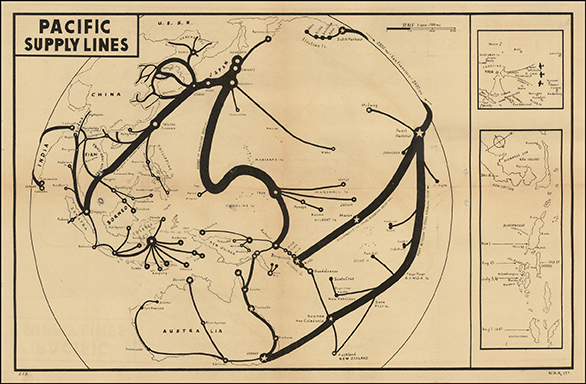
While Mahan acknowledged that “flood… may never come,” its wide range of possible geographies and events would nonetheless need to be predicted and prepared for with utmost vigilance.23 It was in this originary scope of geopolitics (a term inspired by Mahan24) as racialized organicism that the Game plotted and tested hundreds of transpacific campaigns both likely and far-fetched. Mahan’s naval strategy—that a single, decisive battle could bring about the total capitulation of the enemy nation—attuned the Game to prospect for Roosevelt’s “incalculable moment” as a computable, world-historical coordinate. Each game sought that decisive diagram of counterrevolutionary sea power, a fulcrum on which the tide could be turned back, leveraging “white-world” futures while dissipating foment from Du Bois’ dark, revolutionary sea. Such a Pacific pivot would make of the US “a great world island near the middle of the single great world ocean,”25 a “base of operations” from which “the Sea Power of the civilized world [would] energize” its defense.26 Whatever the geographic scenarios or international alliances of individual games, the Game always flew those two banners of global race war named by Stoddard: that of white-world supremacy and of the rising tide.
Science, Fiction, and the Disorders of Nature
Race war was no accidental ingredient tossed into sea power’s theoretical mill; on the contrary, despite Mahan’s claims to transhistorical principles, sea power and the Game developed in step with growing anxieties over concepts of race retooled by the convergence of colonialism and evolutionary theory.27 If white world-supremacy was not, in fact, inevitable, could it nonetheless be engineered if the causal technics of evolutionary time were distilled, formalized, and operationalized?
The Game coupled to both the speculative, science-fictional structure of feeling cracked open by evolutionary theory and the radical but manipulable contingency it introduced into narratives of human history.28 Making the Pacific into a properly geopolitical domain for playing out evolutionary struggle thus required adopting just the sort of probabilistic causal logic and rule-bound contingency the Game proffered. As a technical instrument of spatial speculation, the Game mobilized the principles of sea power as a geopolitical algorithm for modulating world-historical progress newly entangled with evolutionary development. For Mahan, when correctly tuned, the Game would not only perform modeled fleet “evolutions”—the transition from one tactical formation to another—but “the rational process of estimating the forces at work… approximating” a course to achieve “the natural adjustment” of geopolitical order by “artificial methods.”29 The Game calibrated its strategic laboratory to the very “Order of Nature.”30
By embracing the evolutionary rescaling of strategy, McCarty Little’s analytical instrument for simulation could become Mahan’s computational oracle of transpacific race war. Games against Japan spun up a new hemisphere for that science fictional narrative, suturing together world-history and a world-ocean through race war as mode of evolutionary engineering. With the ocean-room as its open-plan computer, the Game systematized the contingencies of transpacific war into discrete, calculable events to be explored through meticulous, mathematically defined procedures, with just enough randomness injected to account for the realism of chance and the irruption of the improbable. By charting possible courses that this war might take, it mapped out forking paths of decision and requisite spatial networks for and against the sea powers in play.
Speculation on the outbreak and direction of transpacific race war captured the popular press and literary imagination in Japan and the US and fed back into game scenarios in both countries.31 One Japanese novel imagined the coordination of Japan’s campaign with a domestic uprising lead by Marcus Garvey, with the latter delivering a poetic death blow to American empire.32 The “science” of the Game fed a more widespread taste for its fictions, and those fictions were reanimated for scientific study in turn. The result was a kind of machinic production of geopolitical narrative, an automatic writing of global race war. The Game manuals can be read, in this sense, as an experimental program for the computational production of these narratives, and the Game as an obscure subgenre of evolutionary science fiction.

Expanding its cinematographic construction, the ordering function of the Game’s narratives became increasingly linear and dogmatic. Without irony, the NWC recast the Game as a geopolitical technology to restrain the outbreak of the race war that would, on their account, result from Japanese expansion in the Pacific. The Game would be tasked with the anticipatory and indefinite deferral of any entropic “disordering” of white world-supremacy—an artifice to maintain an order no longer guaranteed by nature.33 The inversion of racial hierarchy could not be understood as another global order but only a cascading disorder of evolutionary proportions, effecting a chaos “too far-reaching on white civilization for such a possible eventuality to be accepted.”34 Here Fanon echoes back from the future: “decolonization, which sets out to change the order of the world [is] clearly an agenda for total disorder.”35
Paranoid Geography: Counterrevolutionary Logistics on the Dark Sea
This cascade would take chromatic form. “Orange” (the Game’s color code for Japan) was haunted by a potentially revolutionary blackness: a “dark proletariat” mobilized by the imperial operations of capital at a global scale.36 The Game’s just-so stories and toy empires could not yet claim Pacific futures for their own. As Du Bois explains,
For the first time in a thousand years a great white nation has measured arms with a colored nation and been found wanting. The Russo-Japanese War has marked an epoch. The magic of the word “white” is already broken, and the Color Line in civilization has been crossed in modern times as it was in the great past. The awakening of the yellow races is certain. That the awakening of the brown and black races will follow in time…37
Du Bois would eventually condemn Japan’s racist imperial project as it unfurled across Asian and western Pacific territories. Despite its failed promise, that dark sea, pouring through the breach in the edifice of white supremacy, could not be put back in the bottle. The NWC agreed, filling its curriculum with texts like The Menace of Japan, The Population Problem, and Stoddard’s Rising Tide; its lecture series featured talks like Stoddard’s “Relation of Geography to the Character of Far Eastern Peoples” and “Danger Points in World Affairs from a Racial Point of View.”38
Against this severe forecast of revolutionary race war, each maneuver line drawn to resolve the suite of problems on the ocean-room floor reinscribed the “problem of the color line” into Du Bois’ dark sea. Unforeseen tangents to that line might have represented a decisive flashpoint for race war to be restrained, suppressed, or exploited. NWC alum Bradley Fiske explained that “no matter what plan is to be followed,” the Game must be able to generate “a detailed plan for every contingency… elaborated in such detail that it can be put into operation instantly when the fateful instant comes.”39 American sea power, argued Mahan’s contingent, would thus find its geographic fulcrums less in an empire of overseas colonies than in an anticipatory constellation of ports, bases, coaling stations, telegraph cables, and fortified chokepoints like canals and straits. Restrictions on a naval arms buildup and new base construction in the Pacific following the Washington Treaty of 1922 further shunted preparatory efforts into the more discreet logistical media of war: economic blockade; strategic laying, seizing, and cutting of telegraph cables; the use of at-sea refueling and floating dry-docks; and the arming, training, and logistical support of local “insurgents” as proxy fighters. The Game emphasized or generated these novel infrastructural forms of warfare at the same time it was itself empowered as a strategic infrastructure of speculation.
More broadly, sea power wagered that global hegemony depended not on territorial sovereignty over but on a modulated control of the world ocean and its provincial bodies as a “great commons” and an elemental “medium of communications.”40 Strategic geographies of future war thus resembled the topological geometries of the chart, “the strategist’s real field of operations,” where the most robust network connecting forward positions and home territories through lines of communication would win.41 The counterrevolutionary program elaborated by the Game soon took on the networked, transpacific shape of simulations knitted together by preemptive logistical operations and the infrastructural complex they required. In that combination of logic and logistics, the Game plaited the paranoid preparations for race war and the exercise of sea power into the same speculative geographic program and its set of spatial algorithms.
But still the Game could not find Roosevelt’s long-hunted “incalculable moment,” nor Mahan’s decisive battle. Every strategy seeking to strike at Japan from a forward, colonial base (the Philippines or Guam) was undone by the extraordinary logistical exigencies of steaming across the Pacific in full force. Alternative vectors of attack were tested, and increasingly diffuse and redundant infrastructural geometries of support and supply developed. Cumulative scenarios cobwebbed the atolls and archipelagos of the Pacific into a vast logistical meshwork reaching from Samoa to Midway to the Aleutian Islands.42 Logistics began to “devour all other elements” of strategy.43 Game planners worked in close concert with naval intelligence to develop scenarios around islands deemed to have the right combination of natural infrastructure, resources like coal, and a pliant population easily employed or displaced. At the same time, sea power’s logistical imagination—logistikos, “calculation or reasoning in a mathematical sense”44—was set loose upon its own national resources and populations: strategic raw materials, infrastructural networks of production and circulation, and the problem of radical unionized and racialized labor45 were all drawn into its designs.46 The logistical reason of modernity was not cooked up in a philosophical vat; it was incubated—even partially invented—in the tiled waters of the Pacific over a half-century gaming out race war. 47 That World War II became a war of “production,” “machines,” and, above all else, “a war of logistics,” proved less a description than a self-fulfilling prophecy.48

Unwittingly, however, the infinitely receding horizon of race war unhinged the Game’s calculations from any decisive, strategic end, embedding instead an indivisible and incomputable quantity—World War Zero—into its base program. The logistical imagination of the Game found in the color line not a map but a methodological injunction: to perform a calculus of how, when, and where the color line might fray into geopolitical futures to be pried open or foreclosed. These chartings trace an anticipatory image of race war as prosecuted by sea power and designed through the Game: a color line drawing up its paranoid logistical networks for ever-multiplying geographies of inter-imperial war with Japan; a color line drawing populations across the Pacific into geographies of dispossessed and assimilable labor. Where the first function raised a people into a polity upon which war could be made by another nation—a geopolitical racialization for (race) war addressed to an evolutionary frame—the second fragmented peoples into subalternity, an indigenization without or beneath the nation—a geoeconomic racialization as (race) war addressed to the logistics of empire through which war as evolutionary force could be staged and decided.49 The color line was always undergirded by an imperial logistics of encounter—a logistics that, as Du Bois insisted, simultaneously composed communities of solidarity not merely bound by “color of skin but the deeper experience of wage slavery and contempt.”50
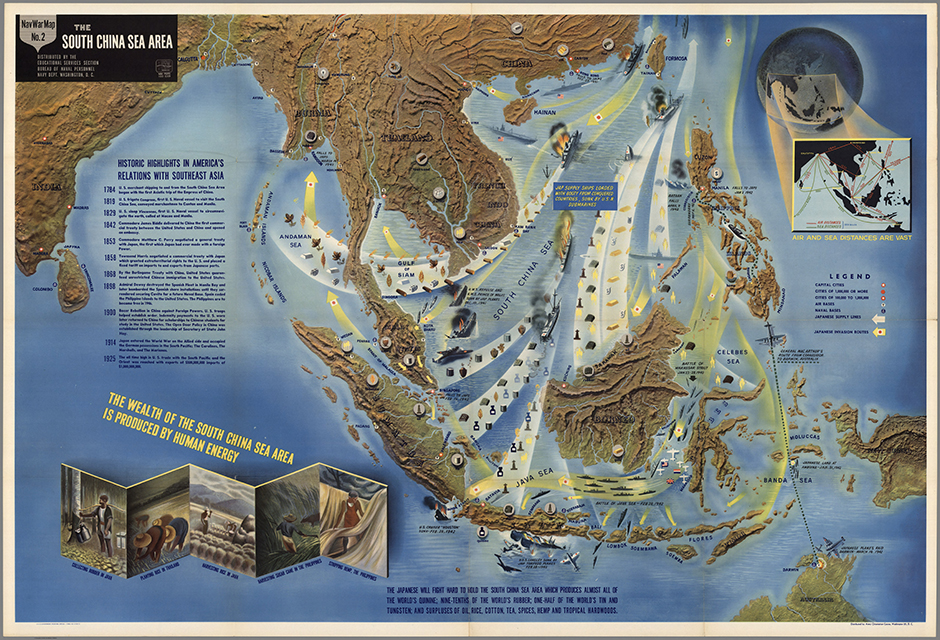
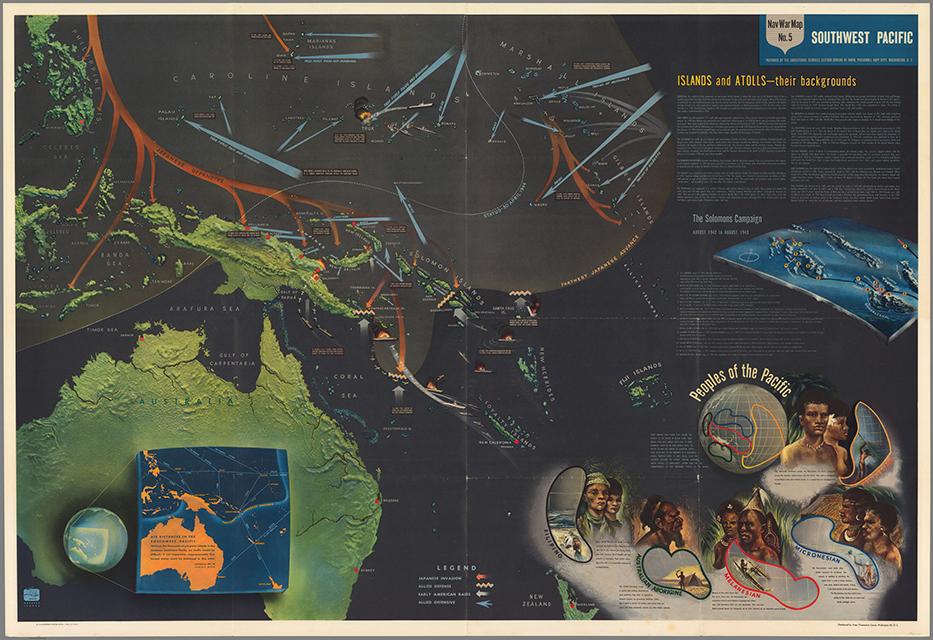
As the Game churned out scenarios against the possibility of Mahan’s flood, plans for “every contingency” began to spill over as well. Nimitz remarked that “the war with Japan had been reenacted in the game rooms by so many people and in so many different ways that nothing that happened during the war was a surprise.”51 When the Japanese attack on Pearl Harbor finally arrived, the US Navy’s Pacific fleet had washed away on the game-room floor almost every year since 1897, with Pearl Harbor itself destroyed at least seven times over.52 They were nonetheless unprepared for that last eventuality. Such is the core paradox of the Game: if nothing was a surprise, nothing in particular could be expected either. This absence of surprise dovetailed with a surfeit of equipotential. The Game plotted a geopolitics of possibility beyond the merely probable, preparing for all alike.53
Foreshadowing the global (race) war on terror a hundred years later, Du Bois mocked this open imperative of infinite “preparedness” with a circular phrasing that could have been lifted from any NWC tract: “The world is not preparing for peace. Everywhere and all over it is not only preparing for war… We must play expensively at war with elaborate maneuvers. Defense, Preparedness—that’s the word. America must be prepared for all eventualities… We must, therefore, be prepared to defend ourselves.”54 For Du Bois, this devouring of strategy by logistics—where strategy is nothing but unbounded preparation—is the pathological program of race war: it is endlessly and everywhere in potentia. Mahan’s geopolitical “horizon of the future” proves an incomputable one—not in the sense that the program cannot run at all but, as in Turing’s sense, that any program designed to solve for it will run indefinitely precisely because there is no computable solution, only further enumerations of the problem.55 For the geographic imagination of American empire, this incomputability might be better described as a spatial paranoia, a sea power decoupled from its element, ever preparing for the long-awaited breach of the bastions of white world-supremacy and the end of empire it foretells.
Coda: Toward a Janitorial Theory of American Empire
We had so many ships to put on and tracks that we used all different colored crayons which were very, very messy. We’d start from one end of the room and swing off on an ark toward the north of the game room and then head out and the ships would end out in the hall. These chalks were very, very soft. They got in your fingers, and they were very, very hard to rub off. I know the janitors had an awful job to erase the lines after the war game was over. The officers themselves got kind of mad certain times when they got chalk all over their clothes and pants. Of course, they had to bend down quite a bit, you know. They got pretty messy.56
In his many rebuttals of Mahan’s maritime panegyrics, Carl Schmitt scolded the dead admiral for failing to see that sea power would overcode landed geopolitics in its image, turning land into island and island into ship. Schmitt explains this transformation by way of comparison between house and ship—the former is grounded, a dwelling, “rest”; the latter is unmoored, “a swimming fort,” incessant “movement” that cultivates an “absolutization of technology” to mediate a volatile and violent environment.57 But something worse lurks in the hypertechnicity of sea-being for Schmitt: a more profound and horrible metamorphosis of the human as such in which the ship becomes a cyborganic sea monster, “Leviathan transformed… from a great fish into a machine” and its acolytes “into machine builders and machine attendants.”58 Schmitt’s dysphoria culminates in a logistical image of empire NWC planners developed through the Game: terra firma annexed by the fluid geographic powers of sea, air, and space, the “planet [transformed] into a combination of produce warehouse and aircraft carrier.”59 The Game, perhaps, goes further: for it is not the ship but the ocean-room that becomes machinic. For a room to become an ocean—this is the ultimate betrayal of the architectonic rooting of earthly geopolitics, and a sign of the saturation of geopolitics by the technopolitical machinations of sea power. Land would finally become nothing but “mere flotsam and an emission of the sea.”60
And here is the unending legacy of the Game, returned as a kind of recursive architectural fable. Though its lines were only drawn in chalk, their geographic afterlives were messy, hard to rub off and erase. Its spatial effluvia are no less sign, performance, enforcement of an originary ordering logic than Schmitt’s landscapes and buildings. But the stack of cinematographic diagrams now appears as a map: a single, senseless frame, a reverse concatenation of imperial futures past, foreclosed, abandoned. In the end, American empire presents itself as a vast pile of toxic trash, scuttled at sea, buried in the earth, leaching everywhere. The catalog of toxicity is an encrypted index of shifting scenarios, severed logistical trains, and deserted tactical materiel: infrastructure and building debris from upheaved airstrips, broken roads, collapsed warehouses and barracks; unexploded ordnance from derelict depots; soil soaked through with oil, abrasives, lubricants; aquifers become subterranean chemical ponds from burst tanks; dismembered machine parts, hemorrhaging machine fuel. These are the relics and refuse not of warfare but of the paranoid peace that prepares for it. Strategies dissolved, the ocean-room at flood tide, the officers leave the room, leaving the janitor holding the mop.
In the late 1950s, Pringle Hall was turned into a coffee mess. Another “monstrous” ocean-room—the Navy Electronic Warfare Simulator or NEWS, a three-story electronic computer—had been built down the road with sufficient computational power to process the now exceedingly complex, globally-scaled logistical problems enshrined by the first Game. New “world games” adopted its early fever dreams of resource scarcity, mass migration, and global militarism on new maps of the world that sea power made.61 The Game was dismantled, its records incinerated, and its pieces cast to the four corners of the earth, the ocean-room finally dissolved into the world-ocean. “The game-board, now, is the great globe itself.”62
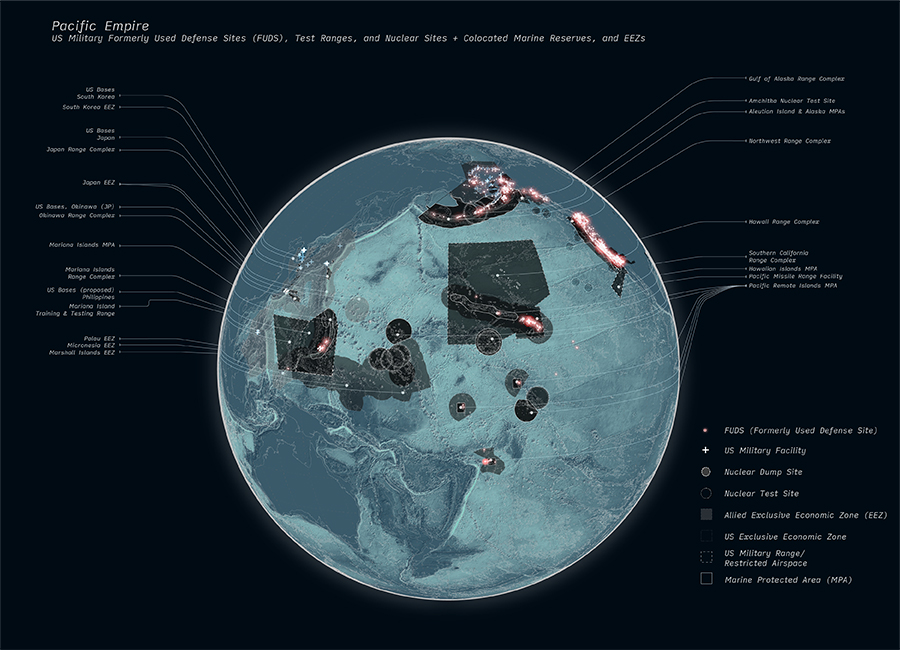
-
William McCarty Little, “The Strategic Naval War Game or Chart Maneuver,” US Naval Institute Proceedings 38, no. 4 (1912): 1218–1219. ↩
-
Little, “Strategic Naval War Game,” 1220. ↩
-
Bradley A. Fiske, The Navy as a Fighting Machine (New York: C. Scribner’s Sons, 1916), 153. ↩
-
Fiske, The Navy as a Fighting Machine, x. ↩
-
A. T. Mahan, The Problem of Asia and Its Effect upon International Policies (Boston: Little, Brown and Company, 1900), 10. ↩
-
Theodore Roosevelt, Presidential Addresses and State Papers (Review of Reviews, 1904), 391. ↩
-
“Outlook for the Dark Races of Mankind,” in W. E. B. Du Bois, The Problem of the Color Line at the Turn of the Twentieth Century: The Essential Early Essays, ed. Nahum Dimitri Chandler (New York: Fordham University Press, 2015), 111–37. ↩
-
Denise Ferreira da Silva, “Globality,” Critical Ethnic Studies 1, no. 1 (2015): 33–38. ↩
-
Edward S. Miller, War Plan Orange: The U.S. Strategy to Defeat Japan, 1897–1945 (Annapolis, MD: Naval Institute Press, 2007), 48. ↩
-
Jodi A. Byrd, The Transit of Empire: Indigenous Critiques of Colonialism, First Peoples: New Directions Indigenous (Minneapolis: University of Minnesota Press, 2011. ↩
-
Denise Ferreira da Silva, Toward a Global Idea of Race (Minneapolis: University of Minnesota Press, 2007). ↩
-
John W. Steinberg et al., Russo-Japanese War in Global Perspective: World War Zero (Leiden, The Netherlands: Brill, 2005); David C. Evans and Mark R. Peattie, Kaigun: Strategy, Tactics, and Technology in the Imperial Japanese Navy, 1887–1941 (Annapolis, MD: Naval Institute Press, 2012), 33, 73–77. ↩
-
Quoted in Gerald Horne, The White Pacific: U.S. Imperialism and Black Slavery in the South Seas after the Civil War (Honolulu: University of Hawaii Press, 2007), 174. ↩
-
Mahan, Problem of Asia, 111–12. ↩
-
Silva, Global Idea of Race, xix. ↩
-
Lothrop Stoddard, The Rising Tide of Color against White World-Supremacy (New York: Scribner, 1920). ↩
-
Stoddard, The Rising Tide of Color against White World-Supremacy, vi. ↩
-
A. T. Mahan, The Interest of America in Sea Power, Present and Future (Boston: Little, Brown and Company, 1898), 123. ↩
-
“The Blue-Orange Situation: Lecture Delivered by Captain R. R. Belknap, U.S.N., for Fleet-War College Sessions, 1 November 1921,” Record Group XIV, NHC. Quoted in Michael Vlahos, The Blue Sword: The Naval War College and the American Mission, 1919–1941 (Newport, Rhode Island: Naval War College Press, 1980), 41. ↩
-
J. O. Dealey, “National Policies in the Pacific,” September 10, 1921, p. 6, Record Group XIV, NHC. Quoted in Vlahos, The Blue Sword, 127. ↩
-
Ian Frazier, “When W. E. B. Du Bois Made a Laughingstock of a White Supremacist,” The New Yorker, August 19, 2019, link. ↩
-
W. E. B. Du Bois, “Black Reconstruction in America: An Essay toward a History of the Part which Black Folk Played in the Attempt to Reconstruct Democracy in America, 1860–1880,” The Oxford W. E .B. Du Bois (New York: Oxford University Press, 2007), 15. ↩
-
Mahan, The Interest of America in Sea Power, Present and Future, 124. ↩
-
German geographer Friedrich Ratzel’s theory of geopolitik and accompanying concept of Lebensraum were a direct response to Mahan’s work on sea power. Gearóid O’Tuathail, Critical Geopolitics: The Politics of Writing Global Space, Borderlines, v. 6 (Minneapolis: University of Minnesota Press, 1996), 30. ↩
-
Captain D. W. Knox, National Strategy. Lecture delivered at the Naval War College, October 7, 1932. Quoted in Vlahos, The Blue Sword, 47–48. ↩
-
Mahan, The Interest of America in Sea Power, Present and Future, 124. ↩
-
Michel Foucault, Society Must Be Defended: Lectures at the Collège de France, 1975–1976, trans. David Macey (New York: Picador, 2003), 57–61, 239–58. ↩
-
John Rieder, Colonialism and the Emergence of Science Fiction (Middletown, CT: Wesleyan University Press, 2008), 109–11. ↩
-
Mahan, Problem of Asia, 46. ↩
-
A. T. Mahan, The Influence of Sea Power upon History, 1660–1783, 4th ed. (Boston: Little, Brown, 1893), 88. ↩
-
John M. Lillard, Playing War: Wargaming and US Navy Preparations for World War II (University of Nebraska Press, 2016), 7. ↩
-
William H. Bridges, Playing in the Shadows: Fictions of Race and Blackness in Postwar Japanese Literature (University of Michigan Press, 2020), 14–16. ↩
-
David Bates, “The Political Theology of Entropy: A Katechon for the Cybernetic Age,” History of the Human Sciences 33, no. 1 (February 1, 2020): 123–24. ↩
-
Vlahos, The Blue Sword, 41. ↩
-
Frantz Fanon, The Wretched of the Earth, trans. Constance Farrington (New York: Grove Press, 1963), 2. ↩
-
Du Bois, Black Reconstruction in America, 16. ↩
-
Du Bois, “The Color Line Belts the World,” in W. E. B. Du Bois, W. E. B. Du Bois: A Reader, ed. David Levering Lewis (New York: H. Holt and Co., 1995), 43. ↩
-
Vlahos, The Blue Sword, 71–74. ↩
-
Fiske, The Navy as a Fighting Machine, 161. ↩
-
A. T. Mahan, Mahan on Naval Warfare: Selections from the Writing of Rear Admiral Alfred T. Mahan, ed. Allan F. Westcott (Boston: Little, Brown, 1918), 75. ↩
-
Little, “Strategic Naval War Game,” 1,213 ↩
-
Wilbur Rice Van Auken, “Operations Problem IV: Analysis of Previous Blue-Orange Problems, Sr. Class of 1933” (December 1933), Publications Office Records, RG-04, Box 94, Folder 18, File 2261-1Q, Naval Historical Collection Archives, US Naval War College, Newport, RI. ↩
-
A. T. Mahan, Mahan on Naval Strategy: Selections from the Writings of Rear Admiral Alfred Thayer Mahan, ed. John B. Hattendorf (Annapolis, MD: Naval Institute Press, 1991), 255. ↩
-
Graham W. Rider, “Evolution of the Concept of Logistics,” Naval War College Review 23, no. 4 (1970): 25. ↩
-
George Cyrus Thorpe, Pure Logistics: The Science of War Preparation (Kansas City, MO: Franklin Hudson Publishing Company, 1917), 89. ↩
-
Naval War College (US), “Study of Strategic Raw Materials in a War between U.S. and Japanese Empire” (August 27, 1922), Intelligence and Technical archives, RG-08-Series I, Box 34, Folder 14, File ULM, Naval Historical Collection Archives, US Naval War College, Newport, RI. ↩
-
Peter A. Shulman, Coal and Empire: The Birth of Energy Security in Industrial America (Johns Hopkins University Press, 2015), Chapter Six: “Inventing Logistics.” ↩
-
NWC alum Admiral Ernest J. King, Commander in Chief, U.S. Fleet, Chief of Naval Operations, March 27, 1944. Quoted in Educational Services Division, Bureau of Naval Personnel, Navy Department, NavWarMap No 6. We Fight a Global War, 97 by 146 centimeters (Washington, DC: US Government Printing Office, 1944), David Rumsey Historical Map Collection. ↩
-
Cf. Deborah Cowen, The Deadly Life of Logistics: Mapping Violence in Global Trade (Minneapolis, MN: University of Minnesota Press, 2014), 27–30, 216–18. Matthew Sparke, “Globalizing Capitalism and the Dialectics of Geopolitics and Geoeconomics,” Environment and Planning A: Economy and Space 50, no. 2 (March 1, 2018): 484–89. ↩
-
Du Bois, The World and Africa, 309. ↩
-
Quoted in McHugh, Fundamentals, 64. ↩
-
Miller, War Plan Orange, 48. ↩
-
Louise Amoore, The Politics of Possibility: Risk and Security beyond Probability (Durham, NC: Duke University Press, 2013), 108–19. ↩
-
W. E. B. Du Bois, “Dusk of Dawn: An Essay toward an Autobiography of a Race Concept,” ed. Henry Louis Gates, Jr., The Oxford W. E. B. Du Bois (New York: Oxford University Press, 2007), 79. ↩
-
A. M. Turing, “On Computable Numbers, with an Application to the Entscheidungsproblem,” Proceedings of the London Mathematical Society s2-42, no. 1 (1937): 230–65. ↩
-
Philip R. Gaudet, Manual War Gaming at the Naval War College, interview by Francis J. McHugh, September 7, 1974, History of Naval War Gaming: Oral History Program, Naval War College, 1974–1975. ↩
-
Carl Schmitt, Land and Sea: A World-Historical Meditation, trans. Samuel Garrett Zeitlin (Candor, NY: Telos Press Publishing, 2015), 79; Carl Schmitt, Dialogues on Power and Space (Malden, MA: Polity Press, 2015), 73–74. ↩
-
Schmitt, Land and Sea, 85–86. In other works, Schmitt connects this machinic metamorphosis with the impossibility of forming the unified racial identity (Artgleichheit) proper to the landed state. ↩
-
Carl Schmitt, The Nomos of the Earth in the International Law of Jus Publicum Europaeum, trans. G. L. Ulmen (New York: Telos Press Publishing, 2006), 49. ↩
-
Schmitt, Land and Sea, 79. ↩
-
Cf. R. Buckminster Fuller, “Fluid Geography,” American Neptune, April 1944; Felicity D. Scott, Outlaw Territories: Environments of Insecurity/Architectures of Counterinsurgency (New York: Zone Books, 2016); Paul Erickson, The World the Game Theorists Made (University of Chicago Press, 2015). ↩
-
Stephen Bleecker Luce, The Writings of Stephen B. Luce, ed. John B. Hattendorf and John D. Hayes, Historical Monographs 1 (Newport, RI: US Naval War College Press, 1975), 40. ↩
Alexander Arroyo is a critical geographer (UC Berkeley, PhD) and environmental designer (Harvard GSD, MLA). His work broadly explores the “geotechnics” of US empire, with a current focus on the Pacific and Arctic oceans. He is author, with Pierre Bélanger, of Ecologies of Power (MIT Press, 2016). As of fall 2021, he is associate director of the Urban Theory Lab and senior research associate in global political ecology at the University of Chicago.

